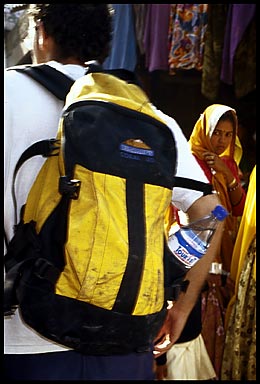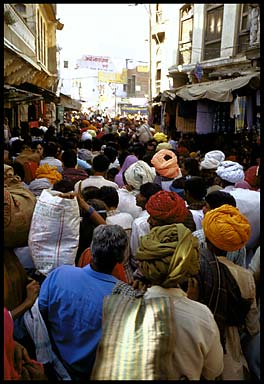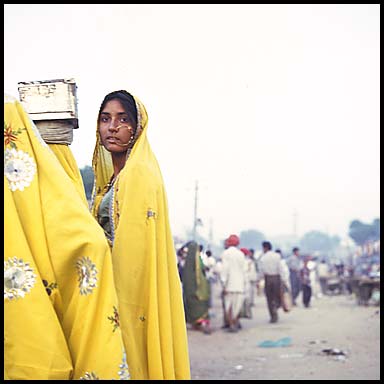Sunday August 5, 2001
I wrote this little essay for Heather but I figured I might as well post it.
This photo, called "Tourist Panni" is one of my favorites to "explain". It has so much loaded up in the accidental moment my camera went off. I like to use it to talk to people about India because it's not what it seems at first, and most people have wildly romantic visions of India.
For me, this photo is the best example of how the tourists --Indian and western -- interact. It's not what you would expect. During the annual camel fair, the villagers that stream into town get to see a lot of things that they don't normally see, (carnival rides, strange food, people from villages hundreds of miles away), but the foreign tourists must be the strangest. At the height of the festival there are hundreds of thousands of people swarming the streets as this photo shows:
As I was moving through this crowd I spotted the guy in "Tourist Panni" and felt compelled to get a shot of his bottle of water. The bottle of water identifies the guy with the backpack as the tourist literally but in fact, he's the "attraction". He's come from half way around the world to look at the exotic things around him but actually he's creating a spectacle even greater than the one he's watching.
If I was to guess who was having more culture shock at this moment, I would have to say the local. The villager woman looking at him, who is making the "pull my sari to cover my face" gesture, may have never seen a white man in person before but what she's really shocked by is the fact that he's not wearing any pants. I couldn't get that in the picture but she's gawking at is his BARE LEGS. Sure, men wear shorts in India but only poor laborers and boys. Men of status only wear pants. To her, a rich westerner is astronomically high in status and yet displaying himself as if he's a beggar.
On top of all that, this display is sexually explicit and that's why she's trying to cover her face. She's not trying to cover it so she won't look, she's trying to cover it so he won't see her. His gaze, especially when he is half naked, defiles her in their culture. Seeing a woman's beautiful face is one step removed from seeing all of her -- and since women and their beauty are possessions, one step from possessing her. Her urge to cover her face is the result of being trained in self-shame, yes, but it's also an attempt to discharge the sexuality of the gaze. Indians are so repressed; they're more sensitive to the power of gaze than westerners are.
When I walked through a new town as stranger looking for a human connection in the faces of the people, and had women cover their faces when they became aware of my presence, I got a palpable sense of what I was being denied. But I could infer what they were being denied: they'll never know a man other than their husband or his brothers.
Purdah, or the traditional practice of covering the face, is one of the things that bugged me most about the northern region of India. When you know why they do it, it becomes a symbol of repression that you see every where you go. After months in India, when so many of the things I saw had become symbols of corruption, repression or stupidity, I had to get out. I loved the moments of revelation and understanding but soon they turned to disappointment and frustration.
All these photos were taken in Pushkar, in the state of Rajastan, India.
Pushkar Village Goddess
I have a lot of opinions about the beautiful yellow piece of fabric that the woman has to wear over her head. I want her to read this web page. Yeah, right. Never gonna happen.
voyeurs of the world, give something back!
Nearby Entries
<prev<----
Home
----
>next>
| Sun | Mon | Tue | Wed | Thu | Fri | Sat |
|---|---|---|---|---|---|---|
| 1 | 2 | 3 | 4 | |||
| 5 | 6 | 7 | 8 | 9 | 10 | 11 |
| 12 | 13 | 14 | 15 | 16 | 17 | 18 |
| 19 | 20 | 21 | 22 | 23 | 24 | 25 |
| 26 | 27 | 28 | 29 | 30 | 31 |
Search
Categories
- blog meta info (23)
- essays (15)
- eyes (6)
- india (10)
- my book (6)
- movies (17)
- music (40)
- photos misc (59)
- cuba photos (24)
- india photos (52)
- san francisco photos (51)
- the mission (19)
- videos (25)
Archives
- May 2006
- October 2005
- September 2005
- May 2005
- April 2005
- March 2005
- February 2005
- November 2003
- October 2003
- September 2003
- August 2003
- July 2003
- June 2003
- May 2003
- April 2003
- March 2003
- February 2003
- January 2003
- December 2002
- November 2002
- October 2002
- September 2002
- August 2002
- July 2002
- June 2002
- May 2002
- April 2002
- March 2002
- February 2002
- January 2002
- December 2001
- November 2001
- October 2001
- September 2001
- August 2001
- July 2001
- June 2001
- May 2001
Recent Entries
- Act Of The Apostle Part 1 May 22, 2006 10:42 AM
- Listen to Thomas Friedman October 17, 2005 1:39 AM
- Personal Continuity September 6, 2005 2:28 AM
- White Gold May 17, 2005 5:35 PM
- Hate, lies and perverted racism May 1, 2005 3:33 PM
- Ballroom Chairs April 29, 2005 1:21 AM
- Supreme Court to pro-lifers -> deeeenied. March 24, 2005 11:02 AM
- Blurry SFO March 23, 2005 3:38 AM
- A site for the blind March 20, 2005 9:07 PM
- The tube is out! March 19, 2005 10:33 AM



